Strict accounting is important! Standards for the temperature of heating radiators in an apartment

Knowledge of room temperature standards will help to detect the malfunction And apply to the appropriate authority for a decision.
Temperature indicators are regulated by standards GOST and SNiP.
Content
- What are the temperature standards in an apartment according to GOST in winter and summer
- Parameters by which central heating is switched on in a house
- Reasons for the lack of heat in the apartment
- How to measure battery temperature
- What to do if there is no heating and the radiator is faulty
- Useful video
- Conclusion
What are the temperature standards in an apartment according to GOST in winter and summer
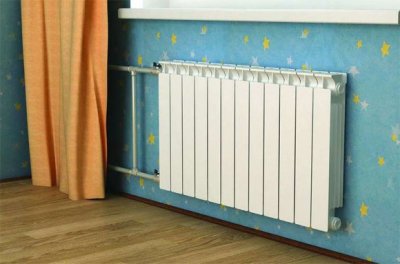
The main indicator is indicated in the document under the number 51617-2000. According to it, the temperature should be:
- on the flight of stairs - 14-20 degrees;
- in the lobby and corridors - 16-22;
- in hallways, living rooms and other rooms of the apartment - 18-25;
- in the bathroom - about 24.
Regulates temperature more precisely GOST 30494-2011:
| Time of year | Premises | Recommended value +/- 1 |
| Cold | Residential | 21 |
| Residential, in the north | 22 | |
| Kitchen | 20 | |
| Toilet | 20 | |
| Bathroom | 25 | |
| Inter-apartment corridor | 19 | |
| Children's | 24 | |
| Warm | Any | 23 |
Minimum indicators
Heating of premises is important at any time of the year, but especially in winter.
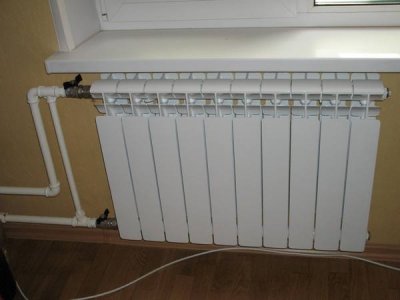
The heating system has typical temperature values that must be observed.
There is a small gap for each room., presented in the table above. There is no minimum threshold as such.
But there are several indicators, the fall below which indicates malfunctions. This concerns heating of premises: the law allows a drop in temperature up to 12, 8 and even 4 degrees, but only for a short period of time - 16, 8 and 4 hours respectively.
Maximum water temperature in radiators
SNiP 41-01-2003 sets temperature limits from above: for a single-pipe piping, heating of the coolant is allowed up to 115 degrees, of the two - up to 95°C. Despite the permitted values, they rarely exceed 80—85°C.
Attention! These rules apply to the in-apartment parts of the heating system.
Parameters by which central heating is switched on in a house
The RF Government Resolution characterizes the need to turn on heating at an average outdoor temperature +8°C or less. When warming up, they detect temperature +5°C and more. Both values should hold. at least 5 days in a row.
Reasons for the lack of heat in the apartment
There are 5 problems, each of which has a solution:
- Wear of the harness during operation
A high percentage of apartment buildings were built in the Soviet era. Aging pipes and boilers provide the building with heat, but do not have the required efficiency.
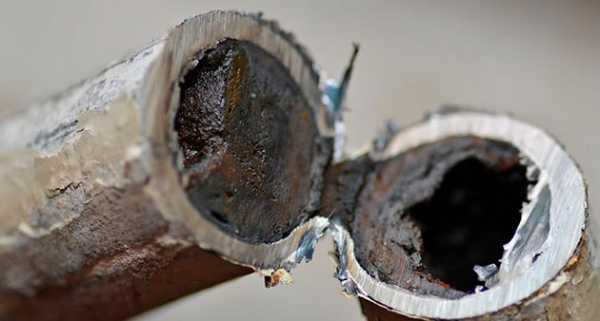
Photo 1. Clogged pipes in the old heating system. Because of this, the flow of the coolant is disrupted and the radiators do not heat up well.
Obsolete equipment is rarely replaced, distributors lack thermal insulation, and secondary problems arise. The solution is a major overhaul of the entire building's system., but to do this you need to contact the supplier with the relevant act, with the signatures of the residents.
- Poor hardware setup
In some houses, heating maintenance is performed by untrained specialists or qualified personnel who do not have engineering schemes. This leads to incorrect adjustment of the piping, and, accordingly, to disruption of operation. It's a bit more difficult to figure this out: The management company is unlikely to recruit new employees in connection with a single complaint. Therefore, it is recommended to submit a collective letter with a request to resolve such an issue.
- There may be errors that occurred during the creation of the project or installation of the heating system.
They can be fixed with a major overhaul. redevelopment and replacement of pipelines.
- Illegal interference with the design or modification of the harness by the user or third parties.
Some residents of apartment buildings change the heating system in their apartment on their own, without thinking about the consequences for their neighbors. The violations are:
- increased number of radiator sections;
- extended heating area;
- connection of additional equipment, such as heated floors.
- High thermal conductivity of building walls, low radiation protection, other violations of technologies during construction.

This mainly concerns old houses, where insulation is made of low-quality materials or is absent. Over time, they also wear out, which spoils the characteristics.
This results in heat loss to the outside. Sometimes a similar problem affects modern buildings: Builders may use an unsuitable, less efficient, but cheaper alternative.
As a result, the residents suffer. The solution to this problem is almost complete redesign of the heating system, major repairs of the building.
How to measure battery temperature
You can measure the temperature of the radiators as follows:
- Place a container, such as a basin, under the drain tap and place a thermometer in it.
- The valve is opened and the volume is filled with water.
- Waiting for the device to respond.
The obtained temperature value may deviate from those presented in the table above. 1 degree down or 3 degrees up. For example, if according to the documents in the radiator 85 degrees, then it is allowed 84-88. If the temperature drops more, it is necessary to write a corresponding report to the management company or heating service provider. The same applies to excessively high numbers.
There are 5 ways to check temperature:
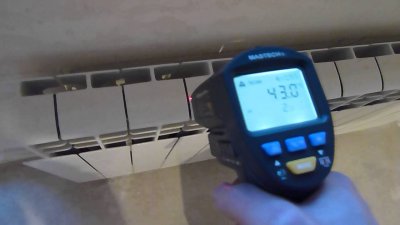
- presented above;
- simply applying a thermometer to the pipes (add to the result two degrees);
- using an infrared pyrometer: it is directed at the piping and the result is awaited, the error is around 0°C;
- An alcohol thermometer is wrapped in heat-resistant material, such as foam rubber, and glued to the radiator with tape, then throughout the day readings are taken every hour;
- use an electrical meter, fixing the sensor to the harness.
Along with the temperature, you should check the system pressure by installing a pressure gauge. If the indicator exceeds 2 atmospheres, you need to file a complaint about air locks with the housing office. This problem is also easy to detect when draining water.
How to adjust and increase heat output
To change the temperature of heating radiators, it is necessary to install special regulators on them. There are 4 types of such devices: regulators with a shut-off mechanism, valves with manual control, thermostats with automatic settings, radiator thermostats.
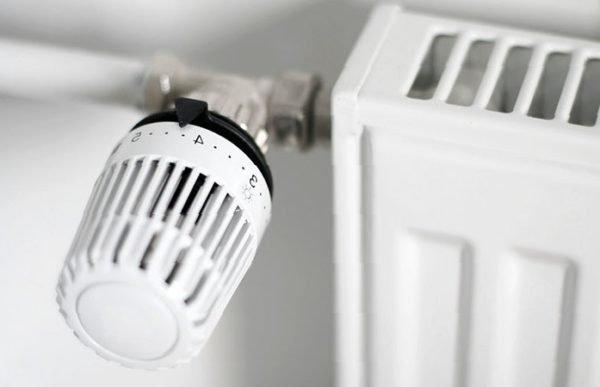
Photo 2. Manual thermostat for a heating battery. By turning the handle, you can set the appropriate temperature.
In order to increase the temperature of the radiator, it is necessary to open the regulator and let more coolant into the heating device. And, conversely, to lower the temperature, it is necessary to release excess coolant.
What to do if there is no heating and the radiator is faulty
Once a problem is discovered, it is necessary to draw up a report, indicating an unacceptably low temperature in the room. They contact the organization supplying heat. The application indicates the period during which the problem has been observed, the actual thermometer readings. Based on the information, they conduct an inspection, calculate compensation, and assign a decision.
According to the law, there may be a break during the heating season for a period of no more than 24 hours per month. The conditions correspond to this: the temperature cannot fall below 12 degrees, and the shutdown should not last 16 hours straight.
Important! There are two exceptions: the premises may contain 8-12 degrees until 8 o'clock in a row or from 4 to 8, but not more than 4.
Useful video
Watch a video that talks about what heating standards should be in an apartment.
Conclusion
Knowledge of SNiP and GOST standards will help to identify the problem, resolve it and receive compensation for the supplier’s failure to fulfill its obligations.







